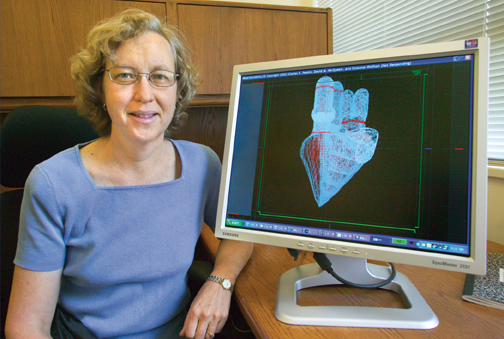
Postdoc Strikes Gold in Ancient Cave Bear DNA
Governor Learns How Lab Can Help Environment
Postdoc Strikes Gold in Ancient Cave Bear DNA
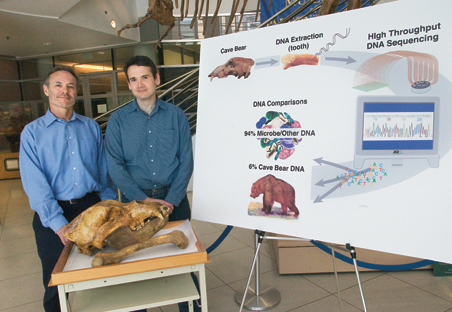 |
||
 |
 |
JGI Director Eddy Rubin (above left) and postdoctoral student Jim Noonan stand before cave bear bones recovered in Europe and a poster that illustrates the generation of ancient DNA sequence. Below right is an artist's rendering of what the now-extinct cave bear might have looked like. |
Jim Noonan cringes at the invocation of Jurassic Park, the typical response he gets to the news that his work on the DNA sequencing of ancient cave bear DNA has been published online in the journal Science. “ As much as the public would like to think that we are going to bring the dinosaurs back, it is not going to happen, at least not by this technology, ” said the Genomics Division postdoctoral fellow who works in the laboratory of Joint Genome Institute (JGI) Director Eddy Rubin. However, Noonan and his colleagues do hope to shed some light through this proof-of-principle work on ancient human ancestors.
From 40,000-year-old bones and teeth found by European collaborators high in the Austrian Alps, Noonan and JGI researchers Chris Detter and Doug Smith extracted snippets of DNA from remnants of the Pleistocene bears. Extinct for more than 10,000 years, these particular cave bears, Ursus spelaeus, whose remains are found in profusion across Europe, were related to the ancestors of modern brown bears and polar bears. Fossil and cave-painting evidence supports that ancient humans interacted with the cave bears.
“ Some people speculate that ’ s why we found human DNA in with the bear nucleic acid, as if that ’ s what the bear had for supper before he settled in for the long hibernation, from which he never awoke, ” Noonan said. “ The reality is that the human DNA we identified from the complex mixture probably came from the paleontologists who handled the cave bear bones. ”
Until now, researchers have been stymied in attempts to sequence genomes of extinct species. DNA starts degrading at death; then micro-bes attack the decaying carcass to utilize the nutrients present in the dead organism as an energy source. What remains to confound the efforts to sequence and characterize these artifacts is an overabundance of microbial contaminants along with the occasional DNA fingerprints contributed unwittingly by modern fossil hunters or lab workers.JGI applied the standard techniques used for modern genome projects to ancient DNA specimens, a brute force high-throughput sequencing approach. With this strategy, the researchers were not distracted by microbe signatures present, but held out hope that among the large amounts of sequence that they did generate would be some of the ancient DNA of interest. “ We were looking for the proverbial needle in the haystack, ” Eddy Rubin said. “ It worked. We were lucky in that we had a very powerful magnet in the form of industrial strength computing to tease out the interesting data from a hodgepodge of different DNAs. ”
It turned out that about six percent of the sequence from the sample yielded cave bear sequence — the rest represented a mosaic of microbial contaminants. Nevertheless within that fraction, there was a range of genomic sequence types, including fragments of 21 genes, identified by comparing the cave bear sample to the complete dog genome sequence that exists in the public databases. Dogs and bears, which diverged some 50 million years ago, are 92 percent similar on the sequence level.
Getting back to the dinosaurs, Noonan said that barring some fundamental misunderstanding about the nature of DNA decay, it is highly unlikely viable DNA will be recovered from 150- to 200-million-year-old Jurassic-age samples. Currently, the theoretical limit is about 100,000 years old for samples preserved in the same conditions that the cave bear specimens were found.
Noonan, who was an undergraduate English literature major bitten by the science bug which led him to doctoral research at the Department of Genetics at Stanford University School of Medicine, never envisioned he ’ d be studying the facets of ancient DNA, previously the stuff of fiction.
“ We picked cave bear as an initial ancient-DNA test case because the samples we used in the study are roughly the same age as Neanderthals, ” Noonan said. “ Our real interest is in hominids, which include humans and the extinct Neanderthal, perhaps our closest prehistoric relative. We hope to soon find out for sure. ”
Governor Learns How Lab Can Help Environment
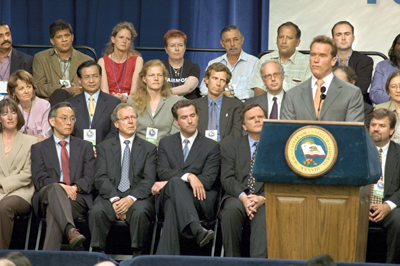 Lab Director Steve Chu (front row at left) was among the dignitaries on stage listening to Governor Schwartzenegger’s press conference on greenhouse gas emissions. The VIP’s included (seated from Chu's left) California EPA Secretary Alan Lloyd, San Francisco Mayor Gavin Newsom, and the Governor’s Chief of Staff, Terry Tamminen.Photos courtesy of Steve McConnell, UC Berkeley NewsCenter
Lab Director Steve Chu (front row at left) was among the dignitaries on stage listening to Governor Schwartzenegger’s press conference on greenhouse gas emissions. The VIP’s included (seated from Chu's left) California EPA Secretary Alan Lloyd, San Francisco Mayor Gavin Newsom, and the Governor’s Chief of Staff, Terry Tamminen.Photos courtesy of Steve McConnell, UC Berkeley NewsCenter
The forum was the kickoff event for the five-day United Nations World Environment Day conference in San Francisco — the first time a North American city had ever hosted this annual international gathering of mayors that devotes its discussions to urban sustainability problems. The Governor took the opportunity to create a California Clean Technologies exhibit in City Hall, and to hold a press conference to announce some ambitious state goals for carbon emissions in the coming years.
The state’s Commission for Jobs and Economic Growth organized the Governor’s showcase “pavilion,” which featured exhibits assembled by eight companies and two academic and research institutions — the latter being the University of California, Berkeley, and Berkeley Lab. Prior to his press announcement about his executive order on June 1, Schwarzenegger took a tour of those exhibits and spoke with the representatives fronting them.
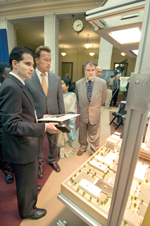 Environmental Energy Technologies scientist Ronnen Levinson (left) explains the urban heat island exhibit to the Governor. Photos courtesy of Steve McConnell, UC Berkeley NewsCenter
Environmental Energy Technologies scientist Ronnen Levinson (left) explains the urban heat island exhibit to the Governor. Photos courtesy of Steve McConnell, UC Berkeley NewsCenter
As he first entered the hall, the Governor was greeted by Chu and by UC Berkeley Chancellor Robert Birgeneau, who immediately gave him a tag-team presentation of advancements in nanotechnology and renewable energy, lighting-control sensors, and “cool colors” roof colorants. Scientific experts backing the leaders included Associate Lab-oratory Director Paul Alivisatos, Environmental Energy Technologies scientists Ronnen Levinson and Francis Rubinstein, and Berkeley professors Kris Pister and Paul Wright.
You can bet Chu carried his message of carbon-neutral energy sources, an initiative to find synthetically produced alternatives to fuel production that Berkeley Lab hopes to lead. And he had a chance to chat about his agenda with the state’s Secretary of the Environ-mental Protection Agency, Alan Lloyd, as they sat in the front row of the dais prior to the Governor’s press announcement.
Chu was also front-and-center in the small group of witnesses who were invited to watch the Governor sign Executive Order S-3-05, which called for a reduction of greenhouse gas emissions to 2000 levels by 2010, a reduction of GHG emissions to 1990 levels by 2020, and a reduction of GHG emissions to 80 percent below 1990 levels by 2050.
The Director said afterward that he plans to visit Sacramento this summer in hopes of convincing the state administration that an investment in energy research programs can leverage additional private and federal support to engage critical fundamental science that underpins the search for new energy sources — and, as a result, a clean and secure energy future for California.
Fair Imparts ‘Wellness’ Tips to Employees
More than 350 employees strolled around the cafeteria lawn last Thursday, enjoying the balmy temperatures while gathering tips on how to become healthier. The first-ever Wellness Fair, sponsored by the Lab’s Health Care Facilitator office, featured chair massages, weight, height, body fat, and blood pressure measurements, music by one of the Lab’s musical groups, and numerous information booths staffed by representatives from a variety of health-related organizations. Organizers considered the event a big success and plan to host another one next year. |
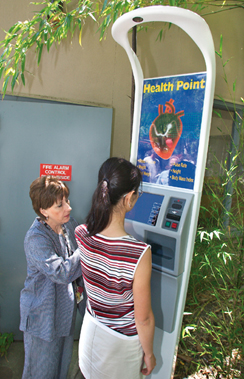 |
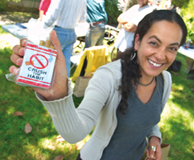 |
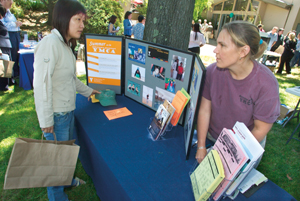 |
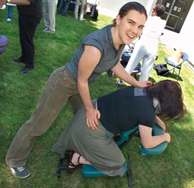 |
Summer Lecture Series
Noon Talks By Scientists Will Focus on ‘Year of Physics’ Theme

With the international “World Year of Physics” as its underlying theme, the 2005 Berkeley Lab Summer Lecture Series will feature seven weekly talks, including the kickoff presentation by Berkeley Lab Director Steve Chu on June 22.
This annual tribute to outstanding Laboratory science and scientists, open to all employees and especially to summer visitors like students and teachers, takes place every Wednes-day at noon in the Building 50 Auditorium, through Aug. 3. Nobelist Chu will focus the inaugural lecture on “Physics Meets Biology.”
The World Year of Physics was declared for 2005 by the Interna-tional Union of Pure and Applied Physics to raise the general public’s awareness of physics and its importance in our daily lives. The celebration coincides with the 100th anniversary of Albert Einstein’s “miraculous year” of 1905, when he wrote his legendary articles that provided the basis of three fundamental principles in physics — the theory of relativity, quantum theory, and the existence of atoms.
With its focus on the field of physics as well as on other sciences to which physics contributes immeasurably, the Summer Lecture Series will offer the talks listed at right:
‘Stunning ’ Results From Heavy-Ion Fusion
Berkeley Lab ’ s Heavy-Ion Fusion group has achieved an experimental success that can arguably be called “ Spectacular! ” Working at their Neutralized Drift Compression Experiment facility (NDCX-1), which has been in operation for only a few months, they have compressed the pulse lengths of an intense beam of positively charged ions an unprecedented fifty-fold. This achievement, which surprised even the scientists who did the experiment, has the potential to substantially reduce the cost of dense plasma physics experiments, and could shorten the development timetable for the heavy-ion approach to fusion energy.
“ The four-nanosecond pulse lengths we produced put heavy-ion beams, for the first time, within range of the pulse lengths necessary for meaningful high energy density physics and for fusion power applications, ” said Grant Logan, a physicist with Berkeley Lab ’ s Accelerator and Fusion Research Division (AFRD), who leads the HIF research effort here and also heads the U.S. heavy-ion Fusion Virtual National Laboratory.
The HIF-VNL is a collaboration between Berkeley Lab, Lawrence Livermore National Laboratory, and the Princeton Plasma Physics Laboratory. It was formed in 1999 to develop heavy-ion accelerators capable of creating fusion reactions for commercial electricity.
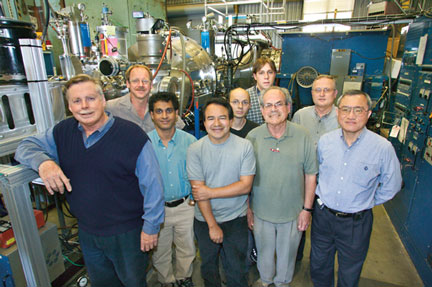 Participants in the NDCX-1 that achieved a stunning 50-fold compression of a Heavy-Ion beam included, from left, Grant Logan, Wayne Greenway, Prabir Roy, Enrique Henestroza, Will Waldron, Josh Coleman, Shmuel Eylon, Frank Bieniosek and Simon Yu. Photo by Roy Kaltschmidt, CSO
Participants in the NDCX-1 that achieved a stunning 50-fold compression of a Heavy-Ion beam included, from left, Grant Logan, Wayne Greenway, Prabir Roy, Enrique Henestroza, Will Waldron, Josh Coleman, Shmuel Eylon, Frank Bieniosek and Simon Yu. Photo by Roy Kaltschmidt, CSO
“ When we began these experiments last year, we believed that we would be able to compress the 200-nanosecond pulse lengths of our heavy-ion beam down to about 10 nanoseconds within two to three years, ” said Simon Yu, the AFRD physicist who leads the HIF-VNL ’ s final beam transport and focusing research effort. “ As far as we can determine, our fifty-fold compression ratio is by far the highest ever reported for an intense, space-charge dominated beam. ”
In these experiments, the Berkeley Lab researchers were able to neutralize the space-charge effects of their heavy-ion beams by sending them through a preformed plasma during compression, rather than a vacuum as is typical for particle beam acceleration. Electrons in the plasma counteracted the mutual repulsion of the positively charged heavy ions that might otherwise have blown the beam apart. Beam compression was achieved by accelerating ions in the tail end of each pulse at a significantly faster rate than particles at the head of the pulse were accelerated.
“ Using an induction tilt core, we create a special waveform that produces a velocity ramp on each beam pulse, ” said Logan. “ As the ions in the tail race to catch up with the ions in the head, it causes the pulse length of the beam to compress. ”
The NDCX-1 experimental results were achieved within four months of initial operation, which began last December. In the last two months, improved diagnostics were applied to confirm these results. Logan and Yu credit much of their ability to score such a stunning success so quickly to an extremely effective team of experimentalists and theorists from both the HIF-VNL collaboration and the Mission Research Corporation, a private firm headquartered in Santa Barbara, CA. They were also helped by highly sophisticated and accurate computer simulations, some of which were conducted at Berkeley Lab ’ s National Energy Research Scientific Computing Center (NERSC).
SNAP 2005: A Year of Progress
Based at Berkeley Lab, the SuperNova/ Acceleration Probe, or SNAP, is a collaboration of over 100 scientists from more than a dozen academic and government institutions in the U.S., Canada and Europe. For three days this week the collaborators met to gauge their progress toward building a satellite that can learn the nature of the dark energy that drives the acceleration of the universe.
SNAP ’ s principal investigator, Saul Perlmutter of the Lab ’ s Physics Division, kicked off the meeting Monday with news from Washing-ton. “ The good news is that people are pushing to get this project out the door. The push is not just coming from DOE. NASA is really on board. ”
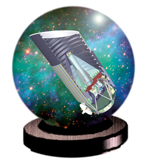
NASA, NSF, and DOE have formed a Dark Energy Task Force charged with helping the agencies make “ rapid progress, ” while NASA ’ s own Universe Exploration Strategic Roadmap committee (whose chair, Anne Kinney, Perlmutter called “ Director of the Universe ” ) gave the NASA/DOE Joint Dark Energy Mission (JDEM) new prominence.
Perlmutter concluded that all signs were good, with “ a strong sense of commitment to JDEM and excitement among members of Con-gress and their staffs, all levels of the federal agencies, and the scientific community. DOE continues to be very supportive, and John Marburger (the President ’ s Science Advisor) has expressed strong support. ”
SNAP ’ s co-principal investigator, Michael Levi of Physics, laid out what it will take for SNAP to win the JDEM competition. “ We have to maintain our leadership and behave like leaders. This means not just doing the appropriate R&D but getting it out into the public domain. ”
Midway through the three-year SNAP R&D process, continued DOE funding seems assured, Levi said, “ so it ’ s time to do less research and more development ” — one goal being to show that “ SNAP is dog-simple, simpler than either JEDI or Destiny, ” SNAP ’ s competitors.
Levi listed understandings achieved with aerospace vendors, universities, and the French Institut National de Physique Nucl é aire et de Physique des Particules for component development, a process he called educational: “ We learned that the cost of a telescope is related to detector performance — better detectors mean a cheaper telescope and could save us a huge amount of money. ”
SNAP project manager Henry Heetderks of UC ’ s Space Sciences Laboratory called this sort of consideration a “ trade study ” and laid out systematic ways to deal with such issues. Heetderks ’ hottest news was purely technical: the revolutionary Berkeley Lab CCD, whose promise has driven SNAP since the beginning, “ has hit a home run, ” demonstrating the performance necessary to make the mission possible.
Steve Holland of the Engineering Division rehearsed the history of the chip of which he is the principal inventor, from first indications that under high voltage the CCD would be rugged, radiation-resistant, and extraordinarily red-sensitive, through to the good news, less than a week old: first tests of the most recent version indicated that “ at 80 to 90 volts we are there, ” meeting SNAP ’ s requirements with excellent performance.
It was the best pep-talk SNAP ’ s team could have wanted as they began three days of hard work on their way to the edge of the universe.
Lab Computer Scientists Show a Lot of Heart
Using a programming language developed to take full advantage of high-performance computing and parallel processing, a collaboration of researchers that includes Katherine Yelick of Berkeley Lab ’ s Computational Research Division (CRD) has developed software that simulates the flow of blood through a human heart. This represents a first step in what Yelick foresees as 3-D digital models of an individual patient ’ s cardiovascular system and internal organs.
|
|
|
| Above: Katherine Yelick, of Berkeley Lab ’ s Computational Research Division, shown here with the heart model she helped create, leads the Future Technologies Group within CRD ’ s High Performance Computing Research Department, and is also a UC Berkeley professor of computer sciences. Right: Model of the human heart created through the use of the Titanium programming language. Photo by Roy Kaltschmidt, CSO |
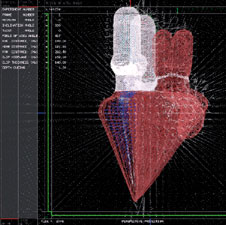
|
“ The long-term goal is to have a complete enough model of a human body that it could be specialized to a particular individual, ” said Yelick, who leads the Future Technologies Group within CRD ’ s High Perfor-mance Computing Research Depart-ment, and is also a UC Berkeley professor of computer sciences. “ In the shorter term, simulations of individual organs will help doctors understand the physiology of how the body works. ”
There ’ s nothing at all simple about the beating of a human heart, not when it comes to the intricate, swirling, pulsating motions of blood flow. Simulating the fluid dynamics behind blood flow through the heart, particularly around the valves that control flow, requires the brute power of the most advanced supercomputers.
However, first you need a programming language that enables model designers to take full advantage of high-performance supercomputers and parallel processing.
Just as development of the programming language JAVA made it much easier for application software to utilize the strengths of the World Wide Web, so did the development of a JAVA dialect called “ Titanium ” make it possible to produce highly detailed simulations of fluid dynamics in biological systems. Titanium was created by the team of Yelick, Berkeley Lab computer scientist Phil Collela, and UC computer scientists Paul Hilfinger and Susan Graham.
“ We want to understand things like how the muscle fibers contract and what happens in the vortices behind the heart valves, ” Yelick said. “ This requires a much higher resolution for more accurate and realistic simulations. ”
In addition to simulating the flow of blood through the heart, software developed by Ed Givelberg, a research scientist who worked in Yelick ’ s group, can also simulate the effects of sound waves in the inner ear, and can be extended to the simulation of blood clotting, bacterial motion, and other biological systems.
Ultimately, Yelick would like to see models of other organs linked to the model of the heart and used in conjunction with medical images and patient histories to create a customized avatar, or digital version of an individual. Physicians could then test drugs for potential side-effects on a patient ’ s avatar, as well as perform virtual surgical procedures, or test donor organs. Diagnostics and potential therapies for strokes, heart attacks, or other catastrophic conditions could also be run on a patient ’ s medical avatar. A programming language like Titanium improves the chances for such virtual simulations becoming a reality.
“ One of the primary motivations for developing Titanium was to enable easier programming on today ’ s parallel architectures, ” Yelick said. ” By providing high-level array abstractions and avoiding tedious message-passing code, Titanium allows application researchers to focus on their science and how to best model it. ”
The Water and Energy Connection

A heat wave struck Europe during the summer of 2003. As temperatures soared, the water in Italy ’ s Poe River became too warm to cool the electric power plants that line its banks. With no way to cool them, the power plants were shut down, as people desperately sought the shelter of air-conditioned buildings. A bad situation became worse.
That same summer, the biggest power outage in American history left tens of millions of people in the northeastern U.S in the dark. Because electricity is used to transport and purify water, the blackout also left many people without tap water.
Although such massive disruptions are rare, they underscore the extent to which water and energy are a package deal.
“ Water is needed to supply energy, and energy is needed to supply water, ” says Jim McMahon, head of the Energy Analysis Department in Berkeley Lab ’ s Environmental Energy Technologies Division (EETD). In the U.S., for example, a whopping 40 percent of the nation ’ s freshwater withdrawal is used to cool electric power plants, which is the same amount of freshwater used by agriculture. On the flip side, three percent of U.S. electricity is used to transport and purify water, which is more than is used by the petroleum refining industry.
To learn how to better manage these deeply intertwined resources, Berkeley Lab established the Water and Energy Technology Team, a group of about 30 scientists and research associates from EETD and the Earth Sciences Division (ESD). The team, cochaired by McMahon and Nigel Quinn of ESD, is working to improve the measurement and forecasting of water supply, demand and quality, as well as develop water and energy-saving technologies.
“ We ’ ve brought together scientists from ESD who have a very good physical understanding of water systems, and researchers in EETD, which has a 30-year history of studying energy efficiency from the policy, economic, and technological side, ” says McMahon.
The clock is ticking. In California, climate change threatens to shrink the Sierra Nevada snowpack that provides the state with a steady supply of fresh water. Nationally, the U.S. population is growing in the South and West, where there is less water to cool electric power plants. And globally, a lack of infrastructure and energy in developing countries means more than one billion people don ’ t have access to clean drinking water.
Berkeley Lab ’ s Water and Energy Technology Team joins 10 other Department of Energy labs working to derail these looming problems. The team has access to the National Energy Research Scientific Compu-ting Center, located at Berkeley Lab, which can churn out regional climate and energy models that predict the supply, demand, and environmental impact of water usage. The team ’ s joint expertise in earth sciences and economic analysis will also help determine whether any newly developed water and energy-saving technologies can survive in a free market. As McMahon explains, a technique that streamlines a power plant ’ s water usage won ’ t be accepted if it ’ s too expensive. Of course, that dynamic could change if water becomes scarce or the cost of treating and delivering it skyrockets.
“ We had the oil shocks in the 1970s, which forced us to pay a lot of attention to oil, ” says McMahon. “ We haven ’ t yet had the national water shocks, but we think they ’ ll come, so it makes sense to look at this now. ”
Coming Soon, a Revolution in the Sciences
A Conversation with John Marburger
BY PAUL PREUSS
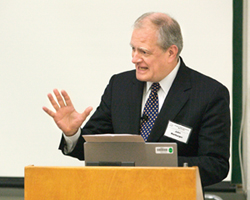
|
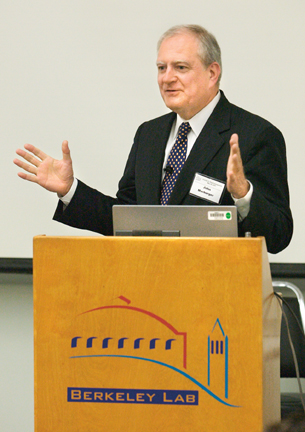
|
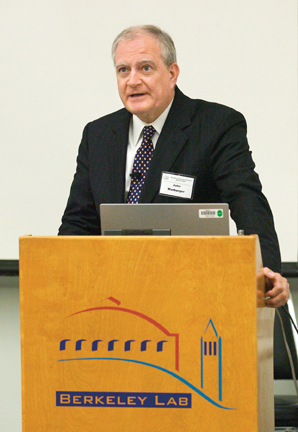
|
|
Marburger spoke at the Charles Shank Symposium during a visit to the Lab last month. Photos by Roy Kaltschmidt, CSO |
|
Among the distinguished speakers at a symposium held May 24 to honor former Berkeley Lab director Charles Shank was John Marburger III, Science Advisor to the President of the United States and Director of the Office of Science and Technology Policy. A pioneer in nonlinear optics, Marburger was professor of physics at the University of Southern Cali-fornia, then professor, dean, and president of the State University of New York at Stony Brook. Subse-quently Marburger was the director of Brookhaven National Laboratory, until his appointment to the Office of the President in 2001.
The View asked Marburger about Charles Shank ’ s contributions and the role of Berkeley Lab and other national laboratories in meeting the nation ’ s challenges in the 21st century.
View: How did you get to know Chuck Shank?
MARBURGER: I met him early on, when we were both doing laser studies in the 1970s, but it was only after I went to Brookhaven as director that I had close contact with him. During lab directors ’ meetings at the Department of Energy in Washing-ton, I was impressed by Chuck ’ s ability to get forward motion — not just toward programmatic ends but toward addressing real needs.
Berkeley Lab ’ s contributions to nuclear and particle physics are legendary, and as the years have gone by successive Lab directors have tried to adjust the operation of the Laboratory to current opportunities in science and the needs of society. During Chuck ’ s era there was a major change in the societal conditions for this kind of work, namely the end of the Cold War. People were saying, “ The Cold War is over, why do we need you any more? ” It was necessary for every national laboratory to readjust its long-range plans and its mission and its relations with Congress and the Department of Energy to fit the rapidly changing conditions.
Berkeley Lab continues to contri-bute to the most fundamental questions of physical science, and the applications area has developed the same way. The Cold War argument has been replaced by an economic-competition argument, and the role of the national labs is now generally accepted in Washington. Chuck ’ s leadership was very important during this period.
It was Chuck who suggested to me that the strength of the national laboratories was not just big mach-ines. “ That ’ s too narrow, ” he said, “ it ’ s our capabilities. ” Typically these are big accelerators or reactors or facilities like the Spallation Neutron Source at Oak Ridge, but they can be clusters of specialized equipment or groups of people who have particular expertise. These give you the ability to tackle a multidisciplinary problem with tools you can ’ t find anyplace else.
View: Please comment on the role of science in addressing the nation ’ s problems.
MARBURGER: On the one hand science is useful for addressing social problems, and on the other hand, there ’ s a kind of human instinct to learn about what ’ s around us. The national labs tend to do research that satisfy both: understanding the environment for humanistic purposes, and understanding the environment to help make life easier.
When it comes to societal issues, energy is the most important by far. The issues of energy are related to national security and economic competitiveness and environmental sustainability, and all these things come together. The way we produce and use energy in society has an enormous impact. I think everyone is aware of the great stress on the environment from our existing energy technologies, and that we ’ re going to have to do something different.
There ’ s going to be a long period of transition to new ways of creating and using energy, producing things with energy — and I mean decades, maybe even centuries, of transition. During this transition period you ’ re going to have many competing or alternative ideas — the number increases as the cost of producing energy goes up. Some of them will turn out to be more effective than others.
There ’ s carbon sequestration, for example, to continue the use of coal, of which there are vast reserves, or exotic extraction techniques for more oil. A lot of attention is going to be paid to the carbon problem — everyone is concerned about that — but also to the issues of energy independence and energy supply.
Different places in the world are going to have different solutions, depending on their unique capabilities and assets. Many people feel that the pressure on the cost of gasoline today is related somehow to the development of Asian societies. We ’ re going to have to respond with new ideas about how to use the energy resources we have — the short-term and intermediate term and long-term solutions are all going to have to work together. Nuclear fusion is way out there, but in the long run that may be what humanity uses.
View: How do you see the relationship between basic research and applied technology in addressing these issues?
MARBURGER: For many centuries, craftsmen tended to develop technologies that were just tools that one needed for getting things done, whereas science was perceived as a sort of a gentlemanly luxury. It wasn ’ t until the middle of the 19th century that science began to produce things that were really useful to technology.
It works both ways. In an effort to solve the problems of society we also advance technology, which provides a context for science. The development of information technology has largely been driven by commercial markets in the last two or three decades. That opened up whole fields for science, and changed the way scientists work.
Today, many people feel that it ’ s just impossible to draw a bright line distinguishing the two, that the old categories of basic and applied science don ’ t capture the spirit of the enterprise. We have to have new ways to see it. For example, if the convergence between cosmology and particle physics had been more visible 20 years ago, we might have a Superconducting Supercollider today. Now we have the excitement of dark energy. It ’ s the spirit of the thing that makes people want to invest.
Some of the greatest advances will come from an extraordinary international set of actors, scientists from Japan, India, Europe, the Americas, elsewhere. One of the glories of the national laboratory system — and something I struggle to educate my Washington colleagues about — is our ability to attract international users. We all ought to be collaborating on the most fundamental science, and perhaps other areas as well.
We are in the early stages of a revolution in how to do science. Now is the time we should be setting our priorities and making our plans.
Visit the Office of Science and Technology Policy website at http://www.ostp.gov/
Quantum Computing: The Future May Be Closer Than We Think
“ Qubits, Quantum Mechanics, and Computers, ” a senior-level course at UC Berkeley, recently inspired Wall Street Journal columnist Lee Gomes to remark that quantum computing is already being “ taught to undergraduates as though it is old hat. ”
Michael Crommie of Berkeley Lab ’ s Materials Sciences Division, a professor of physics at UC Berkeley, teaches the course with Umesh Vazirani, a professor in UC ’ s Depart-ment of Electrical Engineering and Computer Sciences.
“ We start with a foundation in quantum mechanics and only later build up to the machinery we might use, ” Crommie says. One fundamental concept is the superposition of states, familiar from the parable of Schr ö dinger ’ s cat, a creature who is both dead and alive until an observer opens its box to find out.
Unlike the macroscopic cat, most quantum-mechanical systems are superpositions of discrete states like the polarization of a photon or the up or down spin of an electron, which may be in both states at once until measured.
Classical computing is also based on two states, bits of information that are manipulated with binary arithmetic. Each bit is either 0 or 1. A quantum computer ’ s “ qubit ” is different: it represents 0 and 1, both at the same time.
Unlike a classical computer, which essentially represents a discrete number per string of bits, a quantum computer can represent two (states) raised to the power of the total number of its qubits — creating a huge mathematical space for computation. Vazirani calls it “ the private world of Nature, which is extremely complex but pretends to be simple. ”
 An ion implanter (center) places highly charged dopant ions in silicon. By imaging the substrate, the tip of the scanning microscope (lower right) positions the beam, aimed through a narrow hole in the cantilever (upper right). The implanter has been used to spell out LBL in letters only six millionths of a meter high.
An ion implanter (center) places highly charged dopant ions in silicon. By imaging the substrate, the tip of the scanning microscope (lower right) positions the beam, aimed through a narrow hole in the cantilever (upper right). The implanter has been used to spell out LBL in letters only six millionths of a meter high.
Thus quantum computers can perform some calculations that presently can ’ t be done at all, like factoring large numbers. (Factors are the numbers that, multiplied together, yield a given larger number.) Because classical computers bog down when trying to determine the factors of numbers with dozens or hundreds of digits, the difficulty of factoring large numbers has become the basis of modern encryption.
A tangled web of calculation
If qubits are prepared in the right way, a quantum computer can perform a calculation on all of them virtually at once. This is made possible by entanglement, an intimate relationship between two or more individual quantum systems. If two electrons are prepared so that when one is spin-up the other is spin-down, a measurement performed on one instantly determines the state of the other as well. Measuring one of many entangled qubits in a quantum computer instantaneously measures them all.
“ Once the students understand the theory of two-state systems, we look at how we might use it to embody qubits in the real world, ” Crommie says. “ There are lots of possibilities, but we picked just a few: spin is one ... What do you need to do to really put an electron into a superposition? How do you entangle it? ”
Building practical hardware is where classroom guests like Thomas Schenkel come in. A member of the Accelerator and Fusion Research Division ’ s Ion Beam Technology Program (IBT), Schenkel seeks to manipulate information encoded in the electron spin of highly charged dopant atoms embedded in silicon.
“ We want to make the current through a transistor depend on the spin of a single electron in a single atom, ” says Schenkel. “ The expectation is that if we can make one transistor, we can make millions. ”
The goal is to plant single atoms in precise positions in silicon substrates. Single atoms are hard to detect unless highly ionized, but IBT ’ s electron-beam ion trap readily makes very highly charged ions suitable for use with silicon. These are implanted through an extraordinarily narrow passage in or near the tip of a scanning microscope; the tip images the surface of the silicon wafer and positions the ion beam.
Schenkel ’ s group has used the implanter to spell out the letters “ LBL ” with dots in resist on a silicon substrate, each dot aligned to within 10 billionths of a meter. Isolated single ions are easily detected within the dots, but single ions haven ’ t yet been implanted at will.
“ Our ion implanter is a unique way to implant atoms, ” says Schenkel. “ We want to implant just one, but we haven ’ t done the killer experiment yet. ” Nevertheless he expects to demonstrate a layered single-electron transistor, with metal gates on the surface to control input and output, by this August.
Not long thereafter he expects to demonstrate a single-electron MOSFET, a qubit as down-to-earth as the workhorse transistors in a desktop PC. Still, it may take a thousand qubits for a quantum computer to perform dramatically better than classical supercomputers, and the obstacles are formidable.
“ Some people say quantum computing is impossible, the problems are just too hard, ” says Schenkel. “ Others, like myself, say quantum computing is inevitable. We have lots of time to figure out how to get there. ”
Quantum computing is not old hat quite yet, but is clearly on the way.
People, Awards, and Honors
Materials Scientist Gets Vacuum Award

The American Vacuum Society has awarded Berkeley Lab materials scientist and UC Davis professor Charles Fadley its Medard W. Welch Award. He was recognized for “ the development of novel techniques based on photoelectron spectroscopy and synchrotron radiation, and their application to the study of the atomic, electronic, and magnetic structure of surfaces and buried interfaces, and for the mentoring of young scientists. ” The award confers $10,000, a gold medal, certificate, and honorary lectureship at the group ’ s international symposium in October.
Emory & Henry Alum Honored at Graduation

Two Technicians Get Nitschke Award
Ralph Hipple, with the Lab ’ s Engineering Division, and James Wu, with Materials Sciences, are the recipients of the Mike Nitschke Memorial Award. Nitschke was a nuclear scientist here who passed away in 1995. The award honors outstanding technical achievements. Hipple was cited for his “ resourcefulness in originating and encouraging efficient designs and his tireless efforts and long hours in managing the experimental arm of Heavy-Ion Fusion. ” Wu is “ known to some as the Sorcerer for his work with sintered ion sources. His ingenious solutions to unusual problems frequently make the difference between success and failure. ” They will receive their awards at 3 p.m. next Thursday in the Building 66 Auditorium.
Neumark Wins Optical Award

The Optical Society of America as awarded Chemical Sciences Division Director Daniel Neumark its William Meggers award, which recognizes outstanding work in spectroscopy. The award specifically honors Neumark ’ s “ pioneering contributions to the molecular spectroscopy of transient species, including transition state spectroscopy by photo-detachment, the development of anion zero-electron-kinetic-energy spectroscopy and time-resolved photoelectron spectroscopy. ” He will receive the award at the society ’ s annual meeting in October.
Seaborg Joins ‘ Inventors Hall of Fame ’ Ranks
What do Les Paul, inventor of the solid-body electric guitar, and the late Berkeley Lab scientist Glenn Seaborg have in common? Both were recently inducted into The National Inventors Hall of Fame. The induction honors “ the women and men responsible for the great technological advances that make human, social and economic progress possible. ” Seaborg was the Lab ’ s former associate director-at-large, discoverer of 10 elements, and a Nobel Prize winner.
Undergraduate Interns Begin Their Summer Adventure

Nearly 100 undergraduates from colleges and universities around the country gathered for their orientation to the Lab on Monday. They are part of the Department of Energy ’ s summer internship program and will spend about 10 weeks working with Lab scientists and engineers. The students ’ visit is coordinated by the Lab ’ s Center for Science and Engineering Education office.
Berkeley Lab View
Published twice a month by the Communications Department for the employees and retirees of Berkeley Lab.
Reid Edwards, Public Affairs Department head
Ron Kolb, Communications Department head
EDITOR
Monica Friedlander, 495-2248, msfriedlander@lbl.gov
ISSUE EDITOR
Lyn Hunter, 486-4698
STAFF WRITERS
Dan Krotz, 486-4019
Paul Preuss, 486-6249
Lynn Yarris, 486-5375
CONTRIBUTING WRITERS
Jon Bashor, 486-5849
Allan Chen, 486-4210
David Gilbert, (925) 296-5643
FLEA MARKET
486-5771, fleamarket@lbl.gov
Design
Caitlin Youngquist, 486-4020
Creative Services Office
Berkeley Lab
Communications Department
MS 65, One Cyclotron Road, Berkeley CA 94720
(510) 486-5771
Fax: (510) 486-6641
Berkeley Lab is managed by the University of California for the
U.S. Department of Energy.
Online Version
The full text and photographs of each edition of The View, as well
as the Currents archive going back to 1994, are published online on
the Berkeley Lab website under “Publications” in the A-Z
Index. The site allows users to do searches of past articles.
Flea Market
- AUTOS & SUPPLIES
- 97 TOYOTA CAMRY LE V6, $7,000, 50k mi, beige, cloth seats, in dash cd, lojack, very good cond, Gregg, 928-3643 91 TOYOTA TERCEL, 4 cylinder, 4 speed 104K mi, original owner, runs great, nice stereo/speakers $2,500 Dominique @ X7067 or 528-2937
- 89 CELICA ST, original owner, 95K mi, runs very well, normal 16 years of wear, $1,300/bo, Mark, X6581
- HOUSING
- BERKELEY lge studio apt downstairs in home, avail early June, short walk to LBL/pub trans, bay view, priv ent, garden, gas range, refrig, all utils, $895/mo + occasional pet/house sitting, cable internet $25/mo, cable TV $25/mo, first+ last+$400 sec dep, refs & credit rep, John, JLMcCarthy@ lbl.ogv, 841-7875
- BERKELEY resid community of Scientists/staff/grad students, Hearst Commons, 1146-1160 Hearst nr UC/ pub trans/BART, res parking, internet, studio townhouses w/decks, furn can be provided at no cost, hardwd flrs, skylights, dw, ac, intercom, sec, units from $850, 848-5371, Andrew, http://www.live-work.us/
- NORTH BERKELEY, furn room avail in lge, historic Berkeley home, easy walk to Lab shuttle, downtown, shopping, BART, all amenities, perfect for visiting researcher; short & longer term ok, non smoking, limited kitchen privileges currently avail except for August, $500/mo, Rob, 843-5987
- OAKLAND, Rose Garden Dist, charming, sunny & spacious 3 bdrm, 2 bth house, lge liv rm, fp, formal din rm, priv yard w/deck & small lawn, refinished hrdwd flrs, very lge master bdrm w/spacious closets, 1 car garage, w/d, dw, disposal, refrig, range, oven, nr Grand & Piedmont Ave, $2,200/mo, avail June 18, Bill, 428-0748, wjriley@lbl.gov
- TARA HILLS, 2 bdrms for rent in 4 bdrm/2 bth house, share w/ a female, $550/mo avail now, Liz, X2724, 685-0005, Lbear2500@ aol.com
- HOUSING WANTED
- NORTH SIDE of Berkeley, 2 bdrm apartment/condo/cottage/etc, within walking distance to campus, Sarah, 486-7557
- HOUSE SIT wanted Jun 10-17 for very clean & considerate family of 4, couple with their 2 teenage boys 17 & 18 years old visiting from Ohio, Cristina, 234-6962
- LOST
- WATCH with olive leather band, band is about 1 1/2 wide, If found return to Antoinette Bldg. 50A room 4119F, X524
- MISC ITEMS FOR SALE
- BABY CRIB, dark brown wood, incl mattress, $50; stroller, Craco, blue, $15; toddler car seat (20-40 lbs), Kolcraft, blue, $10, Sherry, X6684, 486-8762
- IBM APTIVA 500Mhz, CD ROM, CDRW, 250 Zip, 15” CRT, HP color printer, Scanmagic scanner, Infinity speakers, Intel webcam, $200/BO; Boston HD-7 speakers, $50; Philips DVD $50; Dave, X4506
- PINE CD SHLVS, 160, $10; 200, $15; dining tbl, 36x48 extends to 78, $35; butcher-blk tbl, 26x48x12, $20; workstation 23x36 casters $25, 3 drawer dresser 32x16x32 $10, Joe, X7284
- SF OPERA TICKETS, Pearl Fishers, Sat, 6/18, 8 PM, 2nd row balc pair, $124/pair, Paul, X5508, 526-3519
Flea Market Policy
Ads are accepted only from Berkeley Lab employees, retirees, and onsite DOE personnel. Only items of your own personal property may be offered for sale.
Submissions must include name, affiliation, extension, and home phone. Ads must be submitted in writing
(e-mail: fleamarket@lbl.gov, fax: X6641), or mailed/ delivered to Bldg. 65. Email address are included only in housing ads.
Ads run one issue only unless resubmitted, and are repeated only as space permits. The submission deadline for the June 10 issue is Thursday, June 2.
